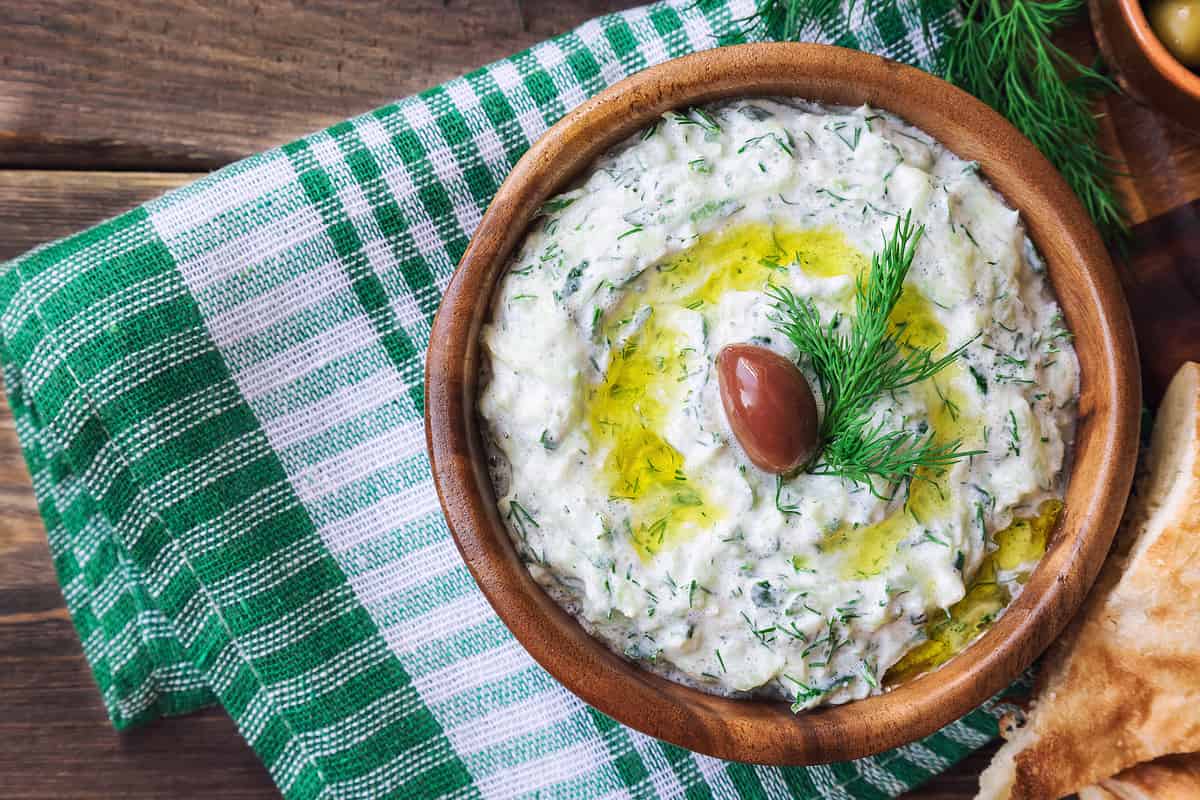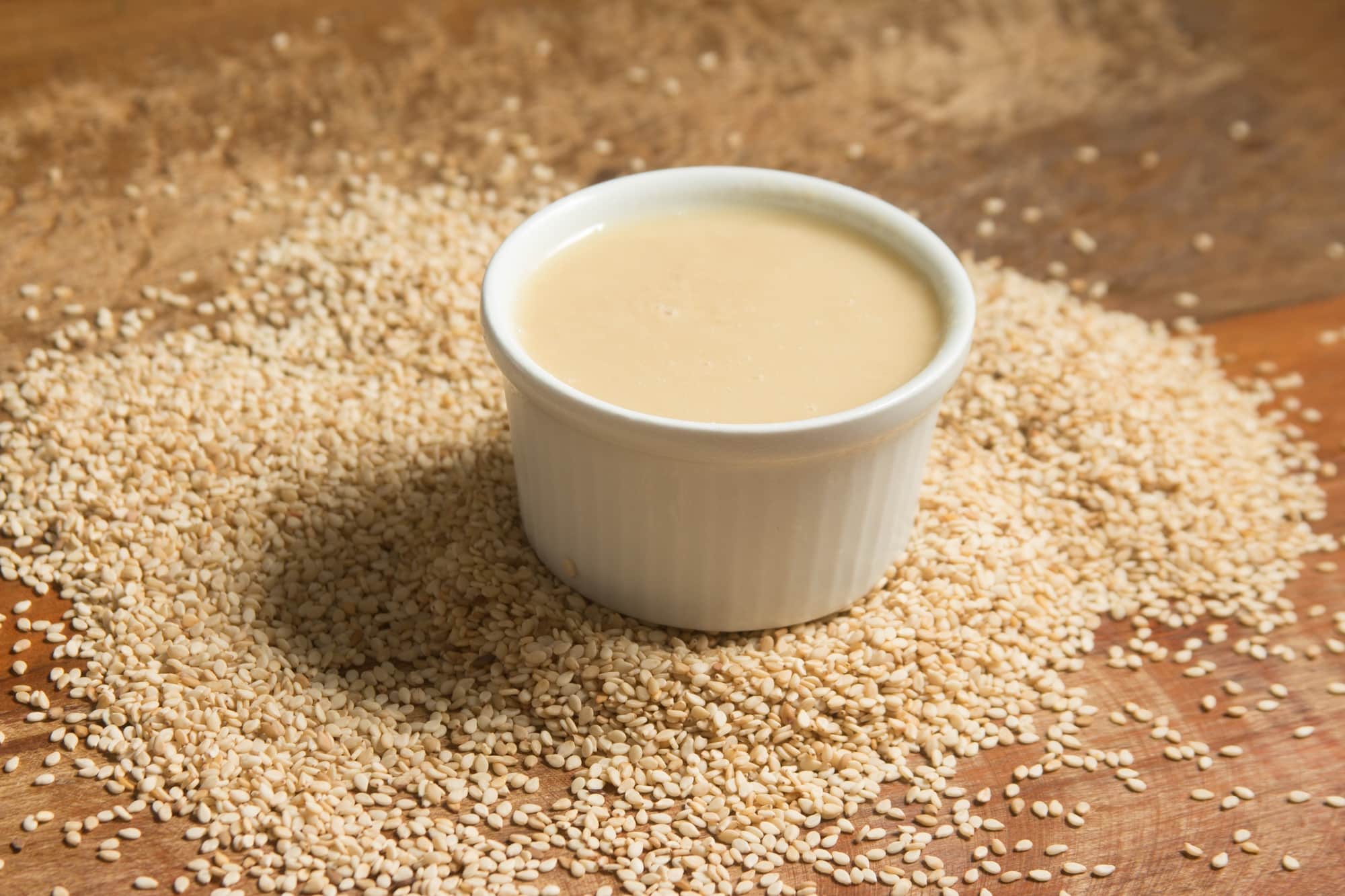Introduction

The Mediterranean region is known for its rich culinary traditions and delightful flavors. One of the highlights of Mediterranean cuisine is the wide variety of condiments that add a burst of flavor to dishes. Two popular condiments in this region are tzatziki and tahini. Tzatziki is a traditional Greek sauce and dip made with yogurt and cucumbers, while tahini is a Middle Eastern paste made from sesame seeds. In this article, we will explore the origins, ingredients, flavors, and cultural significance of both tzatziki and tahini and help you understand when to use each of these delectable condiments.
Historical Background And Popularity Of Mediterranean Condiments
Throughout history, the Mediterranean region has been a melting pot of cultures and traditions, which have greatly influenced its culinary landscape. Condiments like tzatziki and tahini have deep roots in Mediterranean cuisine, drawing inspiration from Greek, Middle Eastern, and Turkish cuisines. These condiments have gained popularity not only in their respective regions but also around the world for their distinct flavors and versatility. Their use in various dishes has made them an integral part of Mediterranean cuisine, showcasing the region’s rich culinary history and cultural diversity.
Origin And Basic Ingredients Of Tzatziki And Tahini
Tzatziki, a traditional Greek sauce and dip, has its origins in the Mediterranean region. It is made with a base of strained yogurt, grated cucumbers, garlic, olive oil, and herbs like dill or mint. On the other hand, tahini is a staple condiment in Middle Eastern cuisine. It is made from toasted and ground sesame seeds, resulting in a smooth, creamy paste. Tahini is often flavored with lemon juice, garlic, and salt for added depth of flavor. Both tzatziki and tahini showcase the use of fresh ingredients and bold flavors in Mediterranean cooking.
Tzatziki

Tzatziki is a traditional Greek sauce and dip known for its tangy and refreshing flavors. Made with a base of strained yogurt, grated cucumbers, garlic, olive oil, and herbs like dill or mint, tzatziki is a versatile condiment that adds a creamy and cool element to meals. It is commonly served with grilled meats, vegetables, or as a dip for pita bread. Tzatziki is not only delicious but also offers health benefits, as it is a good source of probiotics and antioxidants.
Tzatziki: Traditional Greek Sauce And Dip
Tzatziki is a beloved traditional Greek sauce and dip that adds a burst of tangy freshness to any dish. This creamy and smooth condiment is made with a base of strained yogurt, grated cucumbers, garlic, olive oil, and herbs like dill or mint. Its vibrant flavors make it a perfect accompaniment to grilled meats, vegetables, or as a dip for pita bread. Tzatziki’s refreshing taste and versatile nature have made it a staple in Greek cuisine for centuries.
Tzatziki Ingredients And Preparation
Tzatziki is made with a simple combination of ingredients that come together to create a refreshing and flavorful sauce. The main ingredients include strained yogurt, grated cucumbers, garlic, olive oil, and herbs like dill or mint. To prepare tzatziki, the cucumbers are typically squeezed to remove excess moisture before being mixed with the yogurt, garlic, herbs, and olive oil. The mixture is then seasoned with salt and pepper to taste. This creamy and tangy sauce is best served chilled and is a perfect accompaniment to grilled meats, vegetables, or as a dip for pita bread.
Health Benefits Of Tzatziki

Tzatziki not only adds a burst of flavor to your meals, but it also offers several health benefits. This creamy Greek sauce is made with yogurt, which is rich in probiotics that promote a healthy gut and aid in digestion. Tzatziki is also a good source of calcium and protein, which are essential for maintaining strong bones and muscles. Additionally, the cucumber in tzatziki provides hydration, antioxidants, and anti-inflammatory properties.
Tahini
Tahini is a versatile Middle Eastern sauce and spread that has gained popularity worldwide for its unique flavor and creamy texture. It is made from ground and toasted sesame seeds, resulting in a rich and nutty taste. Tahini is a good source of calcium, protein, and healthy fats. It is commonly used in dishes like hummus, dressings, and sauces, adding depth and richness to the flavors. Tahini’s smooth and velvety consistency makes it a perfect ingredient for both savory and sweet recipes.
Tahini: Versatile Middle Eastern Sauce And Spread
Tahini is a versatile Middle Eastern sauce and spread that has gained popularity worldwide for its unique flavor and creamy texture. Made from ground and toasted sesame seeds, Tahini has a rich and nutty taste that adds depth to various dishes. It is commonly used in recipes like hummus, dressings, and sauces, enhancing the flavors with its smooth and velvety consistency. Tahini is also a good source of calcium, protein, and healthy fats, making it a nutritious addition to your meals.
Tahini Ingredients And Preparation

Tahini is made from ground and toasted sesame seeds, which give it its distinctive flavor and creamy texture. The process of making tahini involves roasting the sesame seeds and then grinding them until they form a smooth paste. Some variations of tahini may also include additional ingredients like olive oil, lemon juice, garlic, or salt for added flavor. The preparation of tahini is straightforward and can be done at home using a food processor or blender.
Nutritional Profile And Health Benefits Of Tahini
Tahini is not only delicious but also packed with essential nutrients. It is a rich source of healthy fats, including omega-3 and omega-6 fatty acids, which promote heart health. Tahini is also high in protein, fiber, and various vitamins and minerals, such as calcium, iron, magnesium, and phosphorus. These nutrients support bone health, energy production, and overall well-being. Additionally, tahini contains plant compounds with antioxidant and anti-inflammatory properties, which may help reduce the risk of chronic diseases. Including tahini in your diet can be a nutritious and flavorful addition to your meals.
Flavor And Texture
Flavor and Texture:
Tzatziki and tahini offer distinct flavors and textures that enhance the taste of any dish. Tzatziki has a refreshing tanginess with a hint of garlic and herbs, complemented by the creamy and smooth texture of Greek yogurt. On the other hand, tahini brings a rich, nutty flavor with a velvety and thick consistency. Both condiments add depth and complexity to meals, making them irresistible additions to Mediterranean cuisine. Whether you prefer the cool creaminess of tzatziki or the indulgent creaminess of tahini, these condiments elevate the flavors of your dishes.
Distinct Flavors And Textures Of Tzatziki And Tahini

Tzatziki and tahini offer distinct flavors and textures that enhance the taste of any dish. Tzatziki has a refreshing tanginess with a hint of garlic and herbs, complemented by the creamy and smooth texture of Greek yogurt. On the other hand, tahini brings a rich, nutty flavor with a velvety and thick consistency. Both condiments add depth and complexity to meals, making them irresistible additions to Mediterranean cuisine. Whether you prefer the cool creaminess of tzatziki or the indulgent creaminess of tahini, these condiments elevate the flavors of your dishes.
Pairing And Usage Suggestions Of Tzatziki And Tahini
Tzatziki and tahini are versatile condiments that can be used in various ways to enhance the flavor of dishes. Tzatziki is often enjoyed as a dip for pita bread, vegetables, or grilled meat. It can also be used as a sauce for gyros, kebabs, or sandwiches. Tahini, on the other hand, is commonly used as a spread for bread or as a dressing for salads. It can also be added to hummus or used as a sauce for roasted vegetables. Both tzatziki and tahini can add a unique and delicious twist to your meals.
Culinary Versatility Of Both Condiments
Both tzatziki and tahini are highly versatile condiments that can elevate a wide range of dishes. Tzatziki is perfect as a dip for pita bread, vegetables, or grilled meat, and it brings a refreshing and creamy element to sandwiches and wraps. Tahini, on the other hand, can be used as a spread for bread, a dressing for salads, or added to hummus for a richer flavor. The possibilities are endless when it comes to incorporating tzatziki and tahini into your culinary creations.
Cultural Significance

Tzatziki holds a significant role in Greek cuisine and culture. It is commonly enjoyed with various traditional Greek dishes, such as souvlaki and gyros. Tzatziki represents the freshness and simplicity of Mediterranean flavors and is deeply ingrained in Greek culinary traditions. On the other hand, tahini plays an important role in Middle Eastern cooking and traditions. It is a staple ingredient in dishes like hummus and baba ganoush, showcasing the rich and nutty flavors that are characteristic of Middle Eastern cuisine. Both condiments not only add flavor to dishes but also embody the cultural heritage and culinary traditions of their respective regions.
Tzatziki’s Role In Greek Cuisine And Culture
Tzatziki holds a significant role in Greek cuisine and culture. It is commonly enjoyed with various traditional Greek dishes, such as souvlaki and gyros. Tzatziki represents the freshness and simplicity of Mediterranean flavors and is deeply ingrained in Greek culinary traditions. It adds a cooling and tangy element to dishes, balancing out the richness of meats and other flavors. Tzatziki is often served as a dip or sauce, reflecting the communal and convivial nature of Greek meals. [^31^]
Tahini’s Importance In Middle Eastern Cooking And Traditions
Tahini holds great importance in Middle Eastern cooking and traditions. It is a key ingredient in various dishes such as hummus, baba ganoush, and halva. Tahini has been used in Middle Eastern cuisine for centuries and is deeply rooted in the region’s culinary heritage. It adds a creamy and nutty flavor to dishes and is highly versatile in both savory and sweet recipes. The preparation of tahini has been passed down through generations, and its presence in Middle Eastern cuisine symbolizes tradition and cultural identity. [^34^]
Regional Variations And Adaptations Of Tzatziki And Tahini

Regional variations and adaptations of tzatziki and tahini can be found across different countries and cultures within the Mediterranean region. For tzatziki, variations may include the addition of herbs like dill or mint, as well as the use of different types of yogurt. In Greece, for example, tzatziki is commonly made with Greek yogurt and garlic, while in Turkey, yogurt-based sauces with similar flavors are popular. Similarly, tahini can vary in consistency and flavor depending on the region. In the Levant region, tahini is often smoother and more fluid, while in other areas like Egypt, it may have a thicker consistency. These regional adaptations reflect the local taste preferences and culinary traditions of each area.
Conclusion
In conclusion, tzatziki and tahini are two distinct Mediterranean condiments that bring unique flavors and textures to dishes. While tzatziki is a refreshing and tangy sauce made with Greek yogurt, garlic, and herbs, tahini offers a rich and nutty taste derived from ground sesame seeds. Both condiments have their own cultural significance and can be used in a variety of culinary applications. Whether you prefer the creamy freshness of tzatziki or the savory depth of tahini, these condiments are sure to elevate your Mediterranean-inspired meals.
Comparison Of Tzatziki And Tahini In Terms Of Taste, Ingredients, And Cultural Significance
When comparing tzatziki and tahini, it’s evident that they have different tastes and ingredients. Tzatziki offers a refreshing and tangy flavor due to the combination of Greek yogurt, garlic, and herbs like dill and mint. On the other hand, tahini has a rich and nutty taste derived from ground sesame seeds. In terms of cultural significance, tzatziki is deeply rooted in Greek cuisine and culture, while tahini holds importance in Middle Eastern cooking and traditions. Both condiments bring their unique flavors and cultural influences to the table.
Which Condiment Is Better And When To Use Them?

When choosing between tzatziki and tahini, it ultimately depends on personal preference and the specific dish or cuisine you are preparing. Tzatziki is perfect for adding a refreshing and tangy flavor to Greek and Mediterranean dishes, such as gyros or souvlaki. On the other hand, tahini’s rich and nutty taste makes it ideal for Middle Eastern and Mediterranean recipes, like hummus or falafel. Both condiments bring unique flavors and can elevate any dish they are used in. So, it’s best to experiment and see which one suits your taste buds and culinary needs the most.
Frequently Asked Questions About Tzatziki And Tahini
- What is tzatziki traditionally served with?
Tzatziki is traditionally served with Greek dishes such as souvlaki, gyros, or grilled meats. It can also be used as a dipping sauce for vegetables or pita bread.
- Can tzatziki be made with dairy-free alternatives?
Yes, tzatziki can be made with dairy-free alternatives such as coconut yogurt or cashew cream for those who are lactose intolerant or following a vegan diet.
- Is tahini gluten-free?
Yes, tahini is gluten-free as it is made from sesame seeds, which do not contain gluten. However, it’s always important to read the ingredient labels to ensure there is no cross-contamination.
- Can tahini be used as a substitute for peanut butter?
Yes, tahini can be used as a healthy and flavorful substitute for peanut butter. It adds a rich and nutty taste to recipes like smoothies, cookies, or salad dressings.
- Is tahini high in calories?
Tahini is high in calories due to its healthy fat content. However, it is also packed with nutrients like calcium, iron, and magnesium. Moderation is key when enjoying tahini as part of a balanced diet.
- Can tahini go bad?
Yes, tahini can go bad if not properly stored. It is best to keep it refrigerated in an airtight container to maintain its freshness and prevent it from turning rancid.
- Can tzatziki and tahini be used together?
Yes, tzatziki and tahini can be used together in certain recipes to create a flavor combination. For example, you can use tzatziki as a base for a salad dressing and drizzle tahini on top for added richness.
- Are there any alternatives to tahini?
If you don’t have tahini on hand, you can try substituting it with peanut butter, almond butter, or sunflower seed butter. Keep in mind that the flavors may vary slightly.
Remember, these answers may vary based on personal preferences and dietary restrictions, so it’s always best to adjust recipes according to individual needs.
FAQ: Tzatziki vs Tahini
Q: What is tzatziki?
A: Tzatziki is a traditional Greek dip or sauce made from strained yogurt, cucumber, garlic, olive oil, and various herbs such as dill or mint. It is known for its refreshing and tangy flavor.
Q: What is tahini?
A: Tahini is a smooth paste made from ground sesame seeds. It is widely used in Middle Eastern cuisine and has a rich and nutty flavor. It can be used as a dip, sauce, or ingredient in various dishes.
Q: What are the main ingredients in tzatziki?
A: Tzatziki primarily consists of strained yogurt, finely grated cucumber, garlic, olive oil, salt, and various herbs like dill or mint. Lemon juice or vinegar is sometimes added for a tangy touch.
Q: What are the main ingredients in tahini?
A: The main ingredient in tahini is ground sesame seeds. Some recipes also include a small amount of olive oil and salt, but the purest form of tahini contains only sesame seeds.
Q: How does tzatziki taste?
A: Tzatziki has a cool, creamy, and tangy flavor. The yogurt provides a refreshing base, while the cucumber adds a mild sweetness. The garlic adds a hint of bite, and the herbs provide a fresh and aromatic taste.
Q: How does tahini taste?
A: Tahini has a rich, nutty flavor with a subtle bitterness. The sesame seeds give it a unique taste that can be slightly sweet or slightly savory depending on the quality of the seeds used.
Q: How is tzatziki used in culinary applications?
A: Tzatziki is a versatile sauce that can be used as a dip with pita bread, vegetable sticks, or chips. It is also commonly used as a condiment for falafel, gyros, souvlaki, or grilled meats. It adds a refreshing touch to Mediterranean and Greek-inspired dishes.
Q: How is tahini used in culinary applications?
A: Tahini is a staple in Middle Eastern cuisine and is used in a variety of dishes. It is commonly used as a dip on its own or as an ingredient in sauces like hummus or baba ganoush. Tahini can also be used as a dressing for salads or as a creamy addition to desserts like halva or cookies.
Q: Are tzatziki and tahini similar?
A: Tzatziki and tahini both hail from Mediterranean and Middle Eastern cuisines, but they are distinct in terms of taste and ingredients. While both are creamy sauces or dips, tzatziki is primarily yogurt-based with cucumber and herbs, whereas tahini is a sesame seed-based paste.
Q: Can tzatziki and tahini be used interchangeably in recipes?
A: Tzatziki and tahini have different flavors and consistencies, so they may not work as direct substitutes in recipes. Tzatziki is generally used for its cool and tangy flavor, while tahini adds a rich nuttiness. However, both can be wonderful additions to a diverse range of dishes, each providing its own unique taste profile.
Q: Are tzatziki and tahini suitable for vegetarians and vegans?
A: Tzatziki can be vegetarian if made with dairy-based yogurt, while vegan versions can be prepared using plant-based yogurts. Tahini is naturally vegetarian and vegan-friendly as it is made solely from sesame seeds.
In summary, tzatziki and tahini are both delicious and versatile sauces that bring distinct flavors to culinary creations. Tzatziki offers a refreshing tanginess with a yogurt and cucumber base, while tahini provides a nutty richness from ground sesame seeds. Both can be enjoyed separately or incorporated into a variety of Mediterranean and Middle Eastern-inspired dishes.

We are a small takeaway restaurant offering a great selection of food cooked by our Thai chef. Table spaces are limited, so please book in advance.